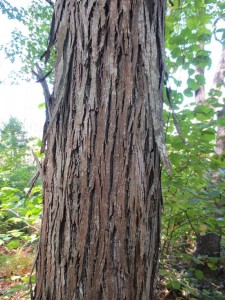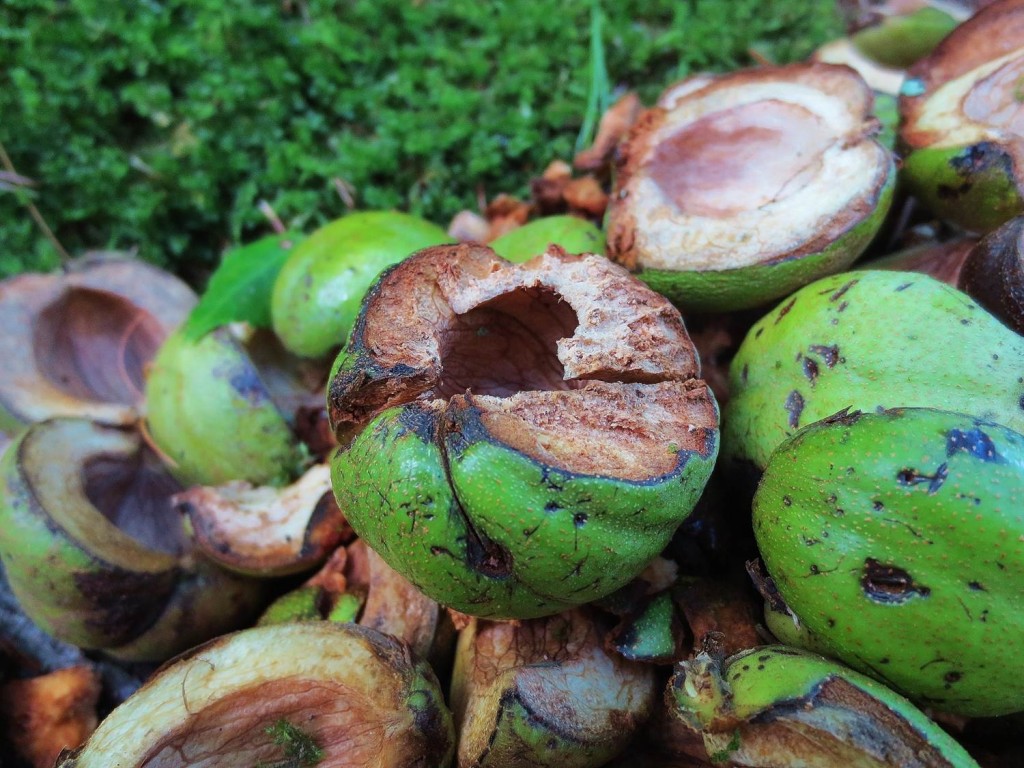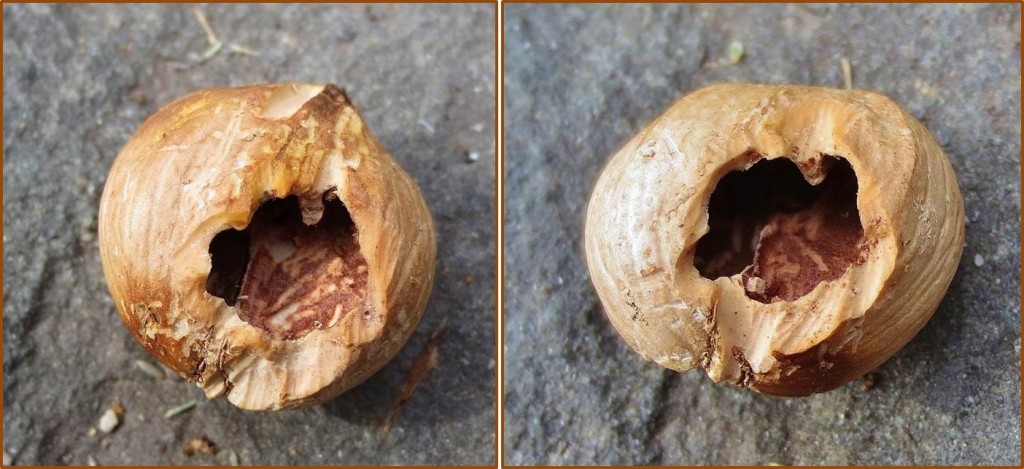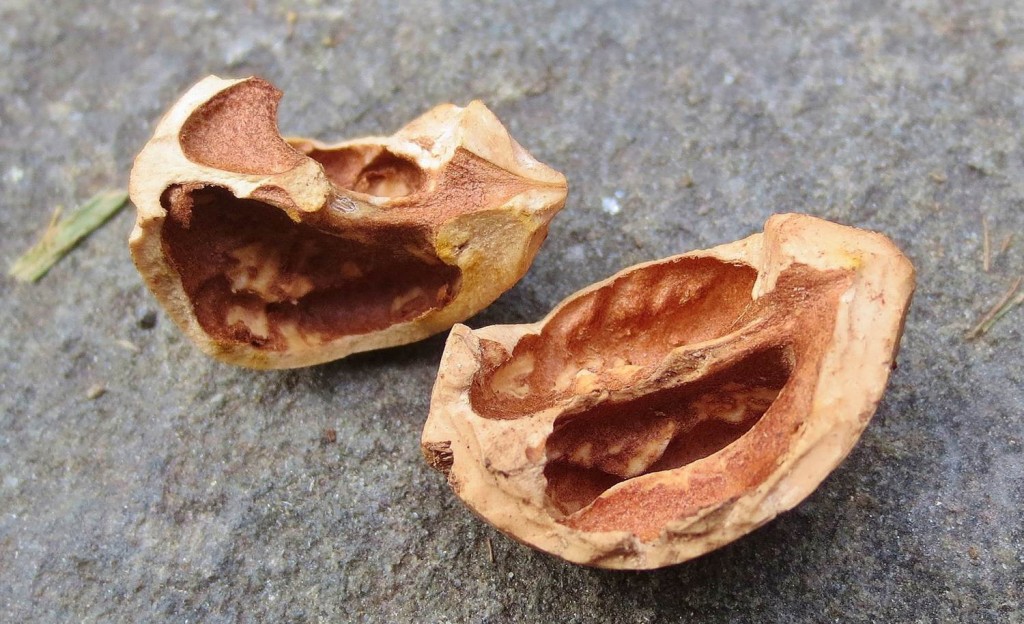While out foraging for shagbark hickory nuts (Carya ovata) in Bolton, MA this morning, I noticed abundant sign of other animals doing the same. Near a beaver wetland in a mixed oak / white pine / red maple / black birch forest, I happened upon one large (about 18 inch diameter) shagbark.
At the base of this tree was a midden pile (2nd photo) of hickory husks, as seen in the second photo. But no nut shell fragments were in the pile, as near I as I could tell. Some husks looked like they had been broken off in their quarter sections, while others had been gnawed open.
There were plenty of small, gnawed husk fragments at the bottom of the midden pile, under the larger pieces. But, again, no shell fragments. The 3rd photo below shows a closeup of a husk on the midden pile at the base of the tree.
There were additional husk fragments scattered around the vicinity of the tree, but I did not find a single shell fragment, and I looked all around within a 5-10 foot radius.
What species do you think created that midden pile, and why do you think so? Why were only husks present?
On my way home, I found many shell and husk fragments under another shagbark hickory tree growing along the side of a road. A few of the nuts had small holes on each side, while many other shells had been broken into small fragments of less than half a shell.
What species might have left the shells with holes on either side, as seen in the photo above (which shows both sides of a single nut)?
What species might have left the smaller shell fragments like the ones in the final photo?
I would love to hear anyone’s thoughts, as I am not totally sure of any of the answers! Please respond in the comments section below. Thanks!
















All I know is that the squirrel’s and the chipmunks share the black sunflower seeds on my bird feeder on a regular basis and I assume they would do the same on any other nuts or seeds in the area.If someone could
set up a video camera where the nuts are we would know for sure.
Ken Nygren
“What species do you think created that midden pile, and why do you think so?” Red Squirrels often create pine cone middens — perhaps a Red Squirrel did this too? Or maybe a Flying Squirrel? Or Eastern Chipmunk?
“Why were only husks present?” I’m guessing the nuts were stashed somewhere safe for later consumption.
“What species might have left the shells with holes on either side…?” I’m thinking Flying Squirrel. I think I can see carrying notching on the pointed end of the shell, though flying squirrels are said to make cleaner circular holes. Mark Elbroch (Mammal Tracks and Sign) writes that Eastern Chipmunks will make jagged, circular holes, and cut less obvious carrying notches. So, maybe chipmunk is a better fit.
“What species might have left the smaller shell fragments…?” I’ll go with Eastern Gray Squirrel. They tend to bust shells up into smaller pieces.
Thanks for the comments! Josh, I agree that the husk pile is most likely the work of a red squirrel, which husked the nuts and then cached them. They have favorite perches where they sit and process their nuts. In this case, I would guess the perch was in the tree above the pile, rather than down on the ground at the pile, because I can’t imagine the animal wasting effort carrying those huge nuts still in the husk, to a processing area. It’s even possible that it cached the nuts in a cavity in the same tree. I thought this was an interesting find, because in all my tracking books, I’ve never seen a picture of a midden of hickory husks.
As for the nuts with the relatively small holes, one on either side of the midrib, I agree that there are carrying notches, and they are fairly robust. As you say, Elbroch says that both southern flying squirrels and chipmunks create carry notches, with chipmunks making more subtle ones, but I’m not sure that means that other species do not. It could just be that he never documented the other species doing it. In any case, the nut could have been carried by one species, dropped, and picked up by another. The holes don’t look like classic flying squirrel holes to me, because they are so jagged. Note that the midrib is intact. Mice make small holes, and are said to not (usually) cut the midrib, but the incisor marks around the edges look awfully big for mice. Red squirrels often enter the nut from both sides of the midrib, so I’m thinking that’s a strong possibility. Chipmunk is also possible. But I’m not sure that the animal that ate the nut is the same one that made the carry notches.
And for the smaller fragments in the final photo, I agree that gray squirrel is most likely.
Ken, you make a good point that nothing is better than 1st hand observation. It bothers me to rely on books. You never really know how many individuals a given author has observed, and there are inconsistencies from author to author.
Pingback: Hickory Nuts: Foraging for Pignut and Shagbark Hickory Nuts - One Acre Farm
I’m sorry it’s been a year since this discussion took place, but this past week I’ve found little (6-10) piles of the hickory nut husks in my front/back yards and 2 stacks in the driveway! I’ve lived in this subdivision for 12 years, and this is a first! I had to ask my son what the husks were. He knew they were hickory nut husks, and since I don’t have a hickory tree, we pwalked around a bit, but didn’t see any neighbors with hickory trees, either. We have plenty if gray squirrels, bunnies, birds, and bats in my central VA neighborhood, but that’s it. I’ve never even seen a chipmunk! My neighbor said she had a gopher in her yard last summer.
I thought you may be interested. Thanks for your time!
Pam
Thanks, Pam, that’s interesting…and puzzling!
I have strong evidence that the hickory nuts with holes on both sides must be made by mice. I had a small stash of hickory nuts in my breezeway which is not accessible to squirrels & chipmunks, but I have caught 14 mice in the breezeway in the last month, and I have found several chewed hickory nuts with holes on both sides, that must have been carried around and eaten by the mice. I didn’t realize that they had such strong jaws!
Kris, yes mice definitely eat hickory nuts and they sometimes enter the nut on both sides. However, I was not asking in general if mice do that, I was asking if anyone could tell from my photo, exactly which rodent made the holes in those shells. Mice usually (not always) make smaller holes in hickory nuts, and the incisor marks on the shells are very small. The incisor marks on the shells in my photo are, I think, too large for mice. I suspect squirrels (probably red squirrel) made those holes.
Here it says the white footed mice eat hickory nuts, among other things
www (dot) psu (dot) edu/dept/nkbiology/naturetrail/speciespages/whitefootedmouse.htm
yes, mice eat hickory nuts. So do many other rodents.
All of the hickory nut husks are very green. I think that means they were picked off the tree and had not fallen to the ground. I think the only animals that can do that are the squirrels. Chip monks don’t climb trees that I know of and mice are out of the question. Only the various species of squirrel, as well as flying squirrels. Let me know what you think.
Yes, the nuts must have been picked off the tree by a squirrel. Chipmunks do climb trees, but I’ve not known them to create midden piles of the size in the photo. It seems most typical of the red squirrel.
Found 4 piles of hickory nut husks in the last 2 days and the closest hickory nut tree that I know of is about 600 yards away.We have many squirels in our yard red black fox gray flying squirels as well as many other critters and this is the first found any nuts in this many locations . This is quite puzzling . Any thoughts?
It just started here a couple days ago pile of shredded nut husk. At first I thought the lawn mower did it, and than realized we don’t have the nuts in our yard. We do Great squirrels and white squirrels. Also wondered skunk? Deer? Or groundhog??